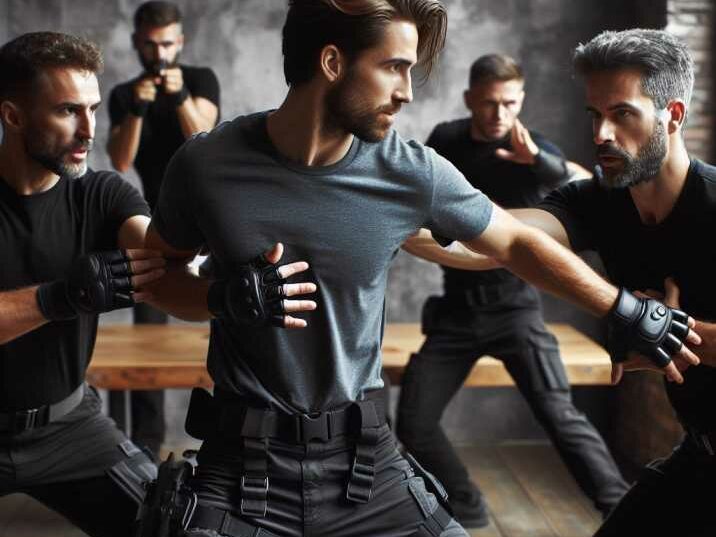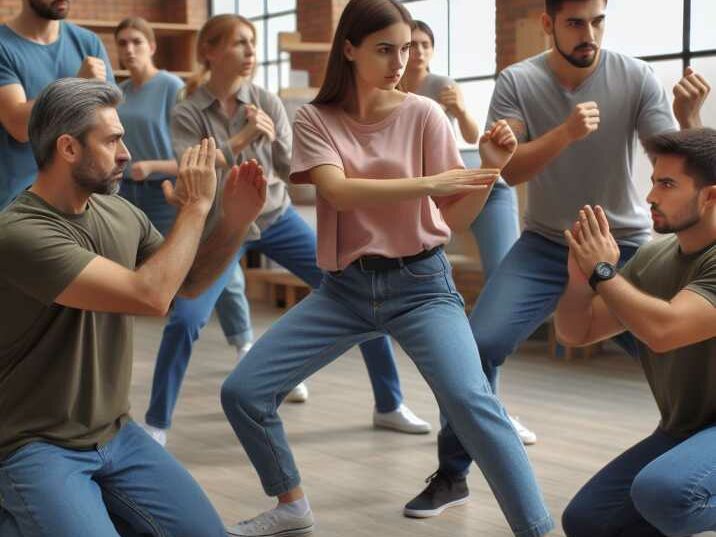Introduction:
Table of Contents
In a world where safety concerns are prevalent, mastering the art of self-defense is paramount. Whether you’re walking home alone at night or facing a potential threat, having the right skills can mean the difference between safety and harm. This guide aims to provide a thorough exploration of street defense martial arts, offering insights into various disciplines, training methodologies, and practical applications. By understanding the nuances of each martial art, you’ll be better equipped to choose the one that best suits your needs and enhances your ability to protect yourself in any scenario.

Table of Contents:
- Introduction
- Understanding the Importance of Street Defense
- Overview of Street Defense Martial Arts
- Historical Context of Street Defense Martial Arts
- Origins and Evolution of Martial Arts for Self-Defense
- Societal Factors and Cultural Influences
- Impact of Globalization on Modern Street Defense
- Criteria for Evaluating Street Defense Martial Arts
- Essential Factors to Consider
- Balancing Practicality and Effectiveness
- Adaptability to Diverse Environments
- The Most Effective Street Defense Martial Arts
- Krav Maga: Practical Self-Defense from Israel
- Brazilian Jiu-Jitsu: Ground Fighting and Submissions
- Muay Thai: The Art of Eight Limbs
- Jeet Kune Do: Bruce Lee’s Philosophy of Martial Arts
- Mixed Martial Arts (MMA): Combining Techniques for Real-World Combat
- Training Methods for Street Defense
- Scenario-Based Training for Realistic Simulations
- Partner Drills for Reflexes and Timing
- Conditioning Exercises for Strength and Endurance
- Mental Preparedness and Situational Awareness
- The Role of Mindset in Street Defense
- Developing Situational Awareness
- Managing Fear and Adrenaline
- Legal and Ethical Considerations
- Understanding Self-Defense Laws
- Principles of Proportionality and Reasonable Force
- Ethical Implications of Martial Arts Training
- Choosing the Right Martial Art for You
- Assessing Personal Goals and Priorities
- Trying Introductory Classes and Workshops
- Finding Reputable Instructors and Schools
- Case Studies and Real-Life Examples
- Success Stories of Street Defense Techniques in Action
- Notable Incidents Demonstrating Martial Arts’ Effectiveness
- Testimonials from Practitioners in Diverse Scenarios
- Equipment and Gear for Street Defense
- Importance of Protective Gear in Training
- Recommended Equipment for Various Martial Arts
- Specialized Gear for Specific Training Needs
- Cross-Training and Supplementary Practices
- Benefits of Cross-Training in Multiple Disciplines
- Supplementary Practices for Enhanced Conditioning
- Integration of Additional Skills for Comprehensive Preparedness
- Community Engagement and Self-Defense Advocacy
- Promoting Self-Defense Education and Empowerment
- Highlighting Organizations and Movements for Street Safety
- Encouraging Advocacy and Support in Local Communities
- Resources and Further Learning
- Curated List of Books, Websites, and Online Resources
- Recommendations for Reputable Martial Arts Schools and Instructors
- Suggestions for Online Forums, Social Media Groups, and Local Meetup Events
- Frequently Asked Questions (FAQs)
- Addressing Common Inquiries and Concerns
- Providing Clarification on Street Defense Practices and Legalities
Unraveling the Essence of Street Defense Martial Arts
- Delve into the core principles of street defense martial arts and their distinctiveness from traditional forms.
- Explore the evolution of street defense techniques, shaped by real-world encounters and survival instincts.
- Highlight the importance of practicality and effectiveness in street defense, emphasizing techniques that prioritize neutralizing threats swiftly and decisively.
Essential Criteria for Evaluating Street Defense Martial Arts
- Establish key considerations when assessing the suitability of a martial art for street defense purposes.
- Emphasize the need for a well-rounded skill set, encompassing striking, grappling, and self-defense techniques.
- Discuss the significance of adaptability and versatility in diverse environments, acknowledging the unpredictability of street confrontations.
Examining the Effectiveness of Prominent Street Defense Martial Arts
- Krav Maga: Originating from military training in Israel, Krav Maga focuses on practical self-defense techniques tailored for real-life scenarios. Its emphasis on simplicity, efficiency, and aggression makes it a popular choice for street defense practitioners.
- Brazilian Jiu-Jitsu (BJJ): Renowned for its ground fighting and submission techniques, BJJ empowers practitioners to control opponents and neutralize threats effectively, even in disadvantageous positions.
- Muay Thai: Known as the “Art of Eight Limbs,” Muay Thai utilizes a combination of punches, kicks, elbows, and knees for devastating strikes. Its emphasis on close-range combat and clinch work renders it highly effective for street defense situations.
- Jeet Kune Do: Bruce Lee’s philosophy of martial arts, Jeet Kune Do, emphasizes simplicity, directness, and adaptability. By incorporating elements from various disciplines, it offers practitioners a dynamic and effective approach to street defense.
- Mixed Martial Arts (MMA): Drawing from multiple martial arts disciplines, MMA provides practitioners with a comprehensive skill set encompassing striking, grappling, and submissions. Its realistic training environment and focus on live sparring make it a valuable asset for street defense.
Effective Training Methods for Street Defense Mastery
- Advocate for scenario-based training to simulate real-life encounters and prepare practitioners for unpredictable situations.
- Highlight the importance of partner drills to develop reflexes, timing, and spatial awareness in dynamic environments.
- Discuss the role of physical conditioning in enhancing strength, endurance, and resilience, crucial for withstanding physical confrontations.
Cultivating Mental Preparedness and Situational Awareness
- Stress the significance of mental fortitude and emotional resilience in street defense scenarios.
- Offer strategies for developing situational awareness to identify potential threats and assess danger levels effectively.
- Discuss techniques for managing fear, adrenaline, and stress responses during high-pressure situations, enabling practitioners to maintain composure and make rational decisions.
Navigating Legal and Ethical Considerations in Street Defense
- Educate practitioners on the legal framework governing self-defense actions in their jurisdiction, emphasizing the principles of proportionality and reasonable force.
- Address ethical dilemmas inherent in martial arts training for self-defense, promoting responsible use of acquired skills and respect for human life.
- Encourage practitioners to seek guidance from legal professionals and ethical mentors to navigate complex moral and legal quandaries.
Personalizing Your Journey: Choosing the Right Martial Art for You
- Encourage individuals to assess their personal goals, preferences, and physical attributes when selecting a martial art for street defense.
- Recommend attending introductory classes or workshops to experience different disciplines firsthand and gauge compatibility.
- Stress the importance of finding a reputable instruc
Historical Context of Street Defense Martial Arts:
- The roots of street defense martial arts trace back to ancient civilizations where individuals developed combat techniques for self-preservation and protection. In ancient China, for instance, techniques like Wing Chun were developed to enable individuals to defend themselves in close quarters combat. Similarly, Japanese martial arts such as Jujutsu and Ninjutsu evolved as practical self-defense systems utilized by warriors and commoners alike.
- As societies evolved, so did the need for effective self-defense techniques. During the feudal era in Japan, for example, Samurai warriors refined their martial skills not only for warfare but also for personal protection in everyday life. Similarly, in Okinawa, the birthplace of Karate, peasants developed defensive techniques to defend against armed attackers, as weapons were forbidden to them.
- The development of street defense martial arts was also influenced by societal factors and cultural influences. In urban environments, where confrontations were more likely to occur, martial arts evolved to emphasize practicality and efficiency. Techniques were adapted to suit the needs of individuals navigating crowded streets and alleyways, where traditional martial arts forms might not be as effective.
Impact of Globalization on Street Defense Martial Arts:
- With the advent of globalization, martial arts began to spread beyond their countries of origin, reaching far-flung corners of the world. This dissemination led to the cross-pollination of techniques, as practitioners from different cultures exchanged knowledge and insights. Consequently, street defense martial arts became more diverse and eclectic, drawing inspiration from various traditions and disciplines.
- Moreover, globalization facilitated the adaptation of martial arts for modern urban environments. As cities grew and became more densely populated, the need for practical self-defense skills became increasingly apparent. Martial arts schools and instructors began to tailor their teachings to address the specific challenges of urban living, focusing on techniques that were effective in confined spaces and against multiple attackers.
Case Studies and Real-Life Examples:
- Numerous real-life examples demonstrate the efficacy of street defense martial arts in protecting individuals from harm. One such case is that of a young woman who successfully defended herself against a would-be attacker using Krav Maga techniques she had learned in a self-defense class. By utilizing simple yet effective strikes and escapes, she was able to thwart the assailant’s advances and escape unharmed.
- In another instance, a martial artist intervened to stop a mugging in progress, using his knowledge of Brazilian Jiu-Jitsu to subdue the assailant without resorting to excessive force. His ability to control the situation and neutralize the threat without causing harm to either party exemplifies the practicality and effectiveness of martial arts training in real-life scenarios.
Equipment and Gear for Street Defense:
- Selecting the right gear is essential for effective street defense training. Protective equipment such as gloves, shin guards, and mouthguards help prevent injuries during sparring and drills. Additionally, specialized equipment such as focus mitts and grappling dummies allow practitioners to refine their techniques and improve their skills in a controlled environment.
- For certain martial arts disciplines, training weapons such as wooden knives or padded sticks are used to simulate real-life threats and practice defensive maneuvers. These tools enable practitioners to develop the muscle memory and reflexes necessary to respond effectively to sudden attacks.
Cross-Training and Supplementary Practices:
- Cross-training in multiple martial arts disciplines can provide practitioners with a well-rounded skill set that is adaptable to a variety of situations. For example, combining striking techniques from Muay Thai with grappling techniques from Brazilian Jiu-Jitsu allows practitioners to seamlessly transition between different ranges of combat.
- Supplementary practices such as strength training, flexibility exercises, and yoga can also enhance overall physical conditioning and resilience. By improving strength, agility, and mobility, practitioners can better withstand physical confrontations and maintain their composure under duress.
- Furthermore, integrating additional skills such as first aid training or conflict resolution techniques can bolster overall preparedness for street defense situations. Being able to administer first aid to oneself or others in the aftermath of an altercation can potentially save lives, while de-escalation techniques can help prevent conflicts from escalating into violence.
Community Engagement and Self-Defense Advocacy:
- Community-based initiatives play a crucial role in promoting self-defense education and empowerment, particularly among vulnerable populations. By providing access to affordable training programs and resources, these initiatives empower individuals to protect themselves and their communities against violence.
- Organizations and grassroots movements dedicated to raising awareness about street safety and self-defense training opportunities play a vital role in fostering a culture of empowerment and resilience. Through workshops, seminars, and outreach programs, they equip individuals with the knowledge and skills they need to stay safe in their everyday lives.
- Encouraging individuals to become advocates for self-defense education in their communities can further amplify the impact of these initiatives. By sharing their own experiences and promoting the benefits of martial arts training, advocates can inspire others to take charge of their personal safety and contribute to creating safer, more resilient communities.
Resources and Further Learning:
- For those interested in delving deeper into the study of street defense martial arts, a wealth of resources and learning opportunities are available. Books, websites, and online forums provide valuable insights into different martial arts disciplines and training methodologies, allowing individuals to expand their knowledge and refine their skills at their own pace.
- Reputable martial arts schools, instructors, and training programs specializing in street defense techniques offer hands-on instruction and guidance for practitioners of all levels. By attending classes or workshops led by experienced instructors, individuals can receive personalized feedback and instruction tailored to their specific needs and goals.
- Online forums, social media groups, and local meetup events provide platforms for practitioners to connect, share knowledge, and support each other’s journey in mastering self-defense. By joining online communities and participating in discussions, individuals can exchange tips, techniques, and insights with like-minded individuals from around the world, fostering a sense of camaraderie and mutual support.
- tor or school that prioritizes practical street defense training, fostering a supportive learning environment conducive to skill development.

Conclusion:
In the realm of street defense, knowledge and preparation are your greatest allies. By immersing yourself in the diverse world of martial arts, understanding their principles, and honing your skills through dedicated training, you can empower yourself to navigate the complexities of urban life with confidence and resilience. Remember, the journey towards mastery is ongoing, but with determination and commitment, you can enhance your ability to protect yourself and others, ensuring a safer and more secure future for yourself and your community.
Frequently Asked Questions (FAQs):
- What is the best street defense martial art for beginners?
- The best street defense martial art for beginners often depends on personal preferences and goals. However, Krav Maga is widely regarded as an effective option for beginners due to its emphasis on instinctive movements and practical techniques that are easy to learn and apply in real-life situations.
- Do I need prior martial arts experience to learn street defense techniques?
- No prior martial arts experience is necessary to learn street defense techniques. Many street defense martial arts, such as Krav Maga and self-defense classes, are designed to be accessible to individuals of all skill levels and fitness backgrounds.
- How long does it take to become proficient in street defense martial arts?
- The time it takes to become proficient in street defense martial arts varies depending on individual factors such as dedication, consistency, and natural aptitude. With regular practice and focused training, students can expect to see progress within a few months, but mastery may take several years of dedicated study.
- Are street defense techniques legal to use in self-defense situations?
- Street defense techniques are intended for self-defense purposes and are legally permissible in situations where individuals need to protect themselves from imminent harm or danger. However, it’s important to be aware of self-defense laws in your jurisdiction and use force proportionally to the threat you’re facing.
- Can street defense martial arts be used by people of all ages and physical abilities?
- Yes, street defense martial arts can be adapted to accommodate people of all ages and physical abilities. Many instructors offer modified techniques and training methods to suit the needs of individuals with disabilities or mobility limitations. It’s essential to communicate with your instructor and adapt the training to your specific needs and capabilities.


